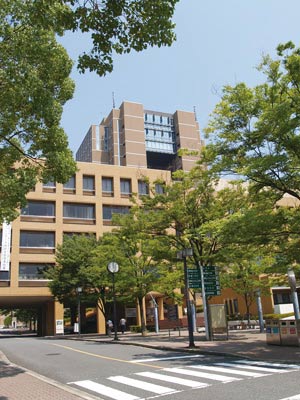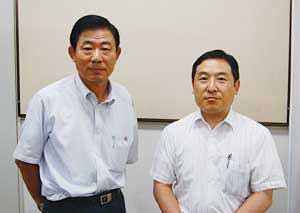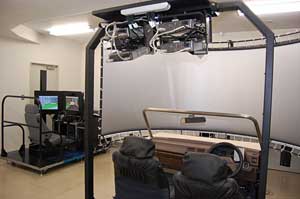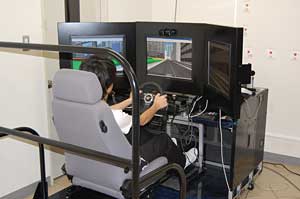Based on the Keyword of "Only One" and "Serve the Society" rather than studying for study,
They Aim for Developing a Driving Ability Judgment System for Aging Society
'To foster talented people who are moderate and impartial, full of ability to act, deserving national and social trustworthiness.'
Reflecting the spiritual legacy of the school's foundation, Meijo University not only boasts its high performance in teacher employment examination in the Tokai Region including Aichi prefecture, but also wins high ranking among all universities in the central districts for the numbers of listed company officers and the management, or the presidents by universities. Accordingly, Faculty of Science and Technology, consisting of 9 departments, corresponds to diversified needs of the time. This time, from Dept. of Information Engineering of the Faculty of Science and Technology, we introduce Dr. Yamamoto's laboratory and Dr. Nakano's laboratory, both of which are building up an excellent presence in the research in ITS (Intelligent Transport Systems) field.
In the department which is characterized by various researches in ITS, Dr. Yamamoto's and Dr. Nakano's laboratories focus on researches that are ahead of the times and further contribute to the society in the fields of image information processing and human interface, respectively. As a part of this, both labs have been jointly developing a system to judge driving abilities of senior drivers. They introduced "UC-win/Road" in the beginning of this year, aiming at realizing various functions required for the system and business expansion in the market as a new step. We interviewed Dr. Shin Yamamoto and Tomoaki Nakano, who paid attentions to this 3D real-time VR (virtual reality) software and the validity of the driving simulator that showed the software's functions to the fullest.
Formerly founded in 1926 (Taisho 15) as Nagoya Science and Technology Course, Meijo University was opened in 1949, with Faculty of Commerce established. On and after 1950, new faculties and schools have been added and modified, including Faculty of Science and Technology.
Having a vision of realizing one of the biggest universities in Japan in which science and literature are united, Meijo Univ. has eight Faculties, namely, Law, Business Management, Economics, Humanity, Urban Science, Science and Technology, Agriculture, Pharmacy, and Graduate Schools located in its campuses of Tempaku, Yagoto (both in Tempaku-ku, Nagoya city), and Kani (in Kani city, Gifu Prefecture). The university has a total enrollment of more than 16,000 students with undergraduate, graduate, and other schools as of May, 2007.
Having a history since the university opening, Faculty of Science and Technology has developed as one of the largest department in the univ. Always working on reforms to get ahead of the time, it currently consists of 9 departments, namely, Mathematics, Information Engineering, Electrical and Electronic Engineering, Materials Science and Engineering, Mechanical Engineering, Transportation Engineering, Civil Engineering, Environmental Science and Technology, and Architecture.
Partly due to the regional environment where automobile manufacturers, including TOYOTA, and automobile-related industries are concentrated, "Not a few teachers in Faculty of Science and Technology, especially in the Department of Information Engineering are focusing on researches in such fields that relate to ITS."
Prof. Shin Yamamoto, who has been involved with the research of ETC from the beginning, mentions a characteristic effort in the univ. Examples of unique attempts in the same Department of Information Technology are as follows: analysis of sound that are easy to hear under a noisy situation for elderly persons whose hearing ability is limited, awakening effects of smells when one becomes sleepy, an approach to detect automobiles coming close by way of sound, and car-to-car communication. Additionally, in the Department of Civil Engineering, diversified researches are focused on, such as simulation of the influence that provision of infrastructure has on traffic flow, or application of phosphorescent and fluorescent materials.
In 2004, Meijo University took part in the "ITS World Conference in Aichi, Nagoya 2004," with those laboratories as a united team, rather than exhibiting per individual lab as many other universities did. This resulted in widely appealing their attitude towards ITS. Since then, this style of presentation took hold, as Prof. Tomoaki Nakano says.
Prof. Yamamoto and Prof. Nakano used to work for TOYOTA Central R&D LBS., INC. Since then, they have been working in the same lab and jointly conducted many researches. Prof. Yamamoto moved to Meijo Univ. in 1998 and Prof. Nakano in 1999. Continuing to work on ITS, Dr. Yamamoto has been studying image information processing, and Dr. Nakano exploring how to utilize it as a human interface, both widely from each stand point and for many years.
"We are conducting onboard technology in advance, so the technology we have actually developed is used by automobile manufacturers and parts manufacturers as a tool for research and development."
Prof. Shin Yamamoto was restructuring his idea that he had incubated since he was working for TOYOTA Central R&D LBS., INC mentioned above into something with longer-term perspective and which is more academic, when he obtained a chance to take part in a project (2003-05) by New Energy and Industrial Technology Development Organization (NEDO). It provided an opportunity to put a new scenario into practice with various participants from Meijo Univ. as well as other organizations such as Advanced Industrial Science and Technology, Aichi Industrial Technology Institute, automobile manufacturers, and parts manufacturers. The result of the research was documented into a report entitled "Human Centered ITS View Aid System," on approaches to monitor external environments and drivers, and to provide necessary information when required by drivers without interfering them.
Moreover, the simulator introduced in the process has also been used in the subsequent ongoing research effectively. For example, Influences of falling asleep, drinking, and a use of cellular phone on drivers or driving conditions, or applications for antitheft devices for cars are investigated using the simulator to the fullest.
On the other hand, Prof. Tomoaki Nakano was mainly in charge of the appropriate ways of providing information with drivers through the displays and alarms of the cars, when he was working for the research and developing company. As a part of this, he devised a system that allows design to meet the natures of elderly people by creating visual function of elderly people virtually. Currently he makes contribution to local communities through these technologies as a center of his research.
"This is what we started with Dr. Yamamoto. Its main purpose is to aid elderly people."
 |
||
 |
||
 |
||
 |
||
(Right) Prof. Tomoaki Nakano from his Laboratory |
||
 |
||
 |
||
(Using "UC-win/Road") |
It must be caused by decline in one's visual function due to general aging, but it is also caused often by lack of the driver's recognition of his own decline in driving ability including the weakened eyesight. Accordingly, they reproduced the situation that is close to an actual driving environment. Elderly drivers were asked to perceive, judge, and operate under various situations that they are likely to face while driving, and had their driving abilities measured. At the same time, an approach was employed to judge one's driving aptitude collectively and objectively, taking the influence of dementia into consideration. He proceeded with system development for this purpose, continuing step-by-step improvement still now.
"We are planning to aim at only-one technology from our unique point of view, and to realize the idea by creating a scenario that is of as long-term as possible."
This is embodied by the aforementioned efforts to investigate the influence of falling asleep and drinking on drivers, for example. About 10 years ago, when Prof. Shin Yamamoto started the investigation, other researches were mainly focused on external environment. On the other hand, he paid attention to such an approach as to measure steering characteristics by way of bionic information that differs from person to person, such as the eye movement of a driver, from early on.
In this sense, Prof. Tomoaki Nakano's work to contribute to aging society by making images an interface is supported by a similar concept.
"The images created by the simulator that I had been using were very poor, though the quality of images was a very important element in proceeding my research," saying Prof. Shin Yamamoto, who remembers how he decided to purchase "UC-win/Road" as a result of each bringing some pieces of information and examining them in order to find its alternative system.
It dates back to nearly four years ago when both professors set to this joint research.
In evaluating elderly people's driving abilities, weight was put on measurement of their visual ability at the beginning. But a typical perimeter only allowed a range to be measured in a suspended situation. For this reason, they developed a system by which a real driving condition is created in combination with a driving simulator, measuring how far on the edge of an eye is viewed. Based on this, various experiments had been conducted, spending about a year. The software of the simulator of that time was only an application of a game, as Prof. Tomoaki Nakano explains.
Next, in last year, taking into account a case of a senior driver who suffers light dementia, they considered measuring abilities of perception and judgment as well as eye sight." In researching various data, we found that only decline in eye function doesn't necessarily connect directly with an accident, and that it is rather likely to occur around an intersection due to a delay in perception or an error in judgment." Then they tried to represent a driving scene for this, which reflects a reality. However, it was difficult to find out a simulator that satisfied the conditions from various aspects like image representations or system sizes.
"A visual field can be expressed very widely. Moreover, cars and pedestrians can also be reproduced with reality improved. And unlike the former ones, the degree of freedom of the display increased." Prof. Tomoaki Nakano lists up the keys to introducing "UC-win/Road," additionally mentioning its compact size as a vital element in considering their plan to supply the products to driving schools and so on as a next step.
At present, both labs are actively creating data towards putting the driving ability judgment system for senior drivers into practice, based on "UC-win/Road." Also, as a further development, they show desire to provide the system with automobile manufacturers or parts manufactures as a system equipped with an originally developed program, or to supply its simplified version with some specialized functions to driving schools etc.
Prof. Shin Yamamoto concerns that discussion on senior drivers are apt to result in the idea of taking cars away from them. In this sense, an attempt for a person to go through a screening for driving abilities should lead to an opportunity to have his or her own capacity to drive accepted depending on the result, assuming the recognition of decline in his own ability, as Prof. Tomoaki Nakano explains his original intention of the work.
"It is possible to know whether the driving ability of a senior person has declined or not, if it is measured. We believe, however, that the simulator will become truly useful through combining it with training to compensate the decline, rather than doing nothing further."
We are most grateful to everyone involved for spending time with us for the interview.


